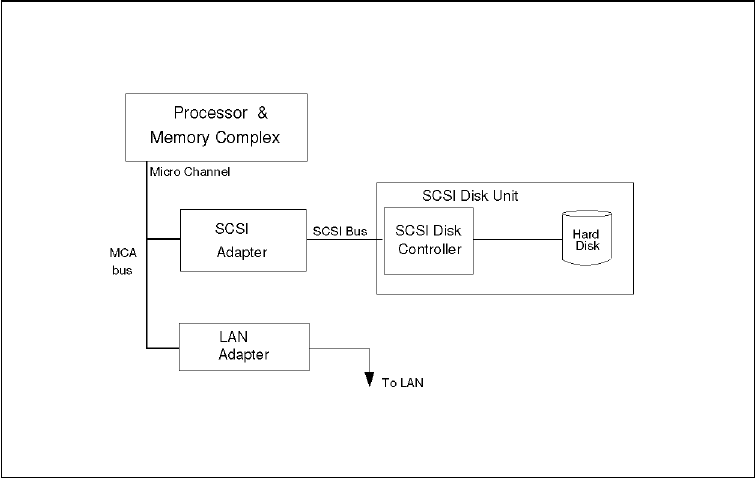Specifications
Table Of Contents
- IBM PC Server and Novell NetWare Integration Guide
- Abstract
- Contents
- Figures
- Tables
- Special Notices
- Preface
- Chapter 1. IBM PC Server Technologies
- Processors
- Clock Rate
- External Interfaces
- Processor Types
- Multiprocessing
- Memory
- Caches
- Memory Interleaving
- Dual Path Buses
- SynchroStream Technology
- Memory Error Detection and Correction
- Standard (Parity) Memory
- Error Correcting Code (ECC)
- Error Correcting Code- Parity Memory (ECC- P)
- ECC on SIMMs (EOS) Memory
- Performance Impact
- Memory Options and Speed
- Bus Architectures
- ISA Bus
- EISA Bus
- Micro Channel Bus
- PCI Bus
- Disk Subsystem
- Hard Disk Interfaces
- SCSI Technology
- SCSI Adapters
- Hard Disk Drives
- RAID Technology
- RAID Classifications
- Recommendations
- LAN Subsystem
- Shared RAM Adapters
- Bus Master Adapters
- PeerMaster Technology
- Security Features
- Tamper- Evident Cover
- Secure I/ O Cables
- Passwords
- Secure Removable Media
- Selectable Drive Startup
- Unattended Start Mode
- Systems Management
- DMI
- SNMP
- NetFinity
- SystemView
- Fault Tolerance
- NetWare SFT III
- Uninterruptible Power Supply (UPS)
- APC PowerChute
- Chapter 2. IBM PC Server Family Overview
- Chapter 3. Hardware Configuration
- The Setup Program
- Main Menu
- Advanced Menu
- Security
- EISA Configuration Utility
- SCSI Select Utility Program
- System Programs
- Starting From the System Partition
- Starting From the Reference Diskette
- Main Menu Options
- Backup/ Restore System Programs Menu
- Set Configuration Menu
- Set Features Menu
- Test the Computer
- More Utilities Menu
- Advanced Diagnostic Program
- RAID Controller Utility
- Drive Information
- Formatting the Disks
- Defining a Hot- Spare Disk
- Creating a Disk Array
- Defining Logical Drives
- Setting the Write Policy
- Initializing the Array
- Backup/ Restoring the Configuration
- Chapter 4. Novell NetWare Installation
- ServerGuide Overview
- Starting ServerGuide
- Installing NetWare 4.1 with ServerGuide
- Installing NetWare 3.12 with Diskettes
- Hardware Requirements
- Software Requirements
- Information Requested at Time of Installation
- Installation Files
- Installation Procedure
- Installing NetWare 4.1 with the Original CD- ROM
- Hardware Requirements
- Software Requirements
- Installation Procedure
- NetFinity Services for NetWare
- System Requirements
- Installing NetFinity Services for NetWare
- The RAID Administration for NetWare Utility
- Installing the Utility
- Hard Disk Failure Simulation
- Simulating with a Hot Spare Drive
- Simulating without a Hot Spare Drive
- Chapter 5. Performance Tuning
- Appendix A. EISA Configuration File
- Appendix B. Hardware Compatibility, Device Driver, and Software Patch Information
- Appendix C. Configuring DOS CD-ROM Support
- List of Abbreviations
- Index
- Special Characters C
- Numerics
- A
- B
- D
- E
- F
- H
- M
- I
- N
- K
- L
- O
- P
- S
- Q
- R
- T
- U
- V
- W
- Z
- ITSO Technical Bulletin Evaluation RED000

4. Small Computer System Interface (SCSI) - The SCSI interface is a high speed
parallel interface that transfers eight bits at a time rather than one bit at a
time for the ST506 and ESDI serial interfaces. Thus data transfer rates for
SCSI are measured in mega
bytes
versus mega
bits
and are considerably
faster than those of the serial interfaces. SCSI is also a bus level interface
which makes it very flexible. Since the commands are interpreted by the
device and not the SCSI host bus adapter, new devices (with new
commands) can be implemented and used with standard SCSI adapters. The
device driver then interacts with the device via the new commands. An
example of this would be a CD-ROM device sharing the same adapter as a
hard disk drive. Figure 10 shows a SCSI subsystem with a host bus adapter
attached to an integrated controller and hard disk.
Figure 10. SCSI Disk Interface
The SCSI flexibility and high performance make it very suitable for the server
environment. In fact, SCSI is the most widely used disk subsystem
technology in advanced servers today. All the current IBM PC Servers
except for a few at the low end use this technology. For these reasons, we
will take a closer look at this interface.
1.6.2 SCSI Technology
As previously discussed, SCSI is a bus level interface through which computers
may communicate with a large number of devices of different types connected to
the system unit via a SCSI controller and daisy-chained cable. The attached
devices include such peripherals as fixed disks, CD-ROMs, printers, plotters, and
scanners. The SCSI controller may be in the form of an adapter or integrated on
the planar board.
There are several terms and concepts used in discussing SCSI technology that
require definition.
•
SCSI-I and SCSI-II:
SCSI is a standard defined by the American National Standards Institute
(ANSI). The original SCSI-I standard is defined in ANSI standard X3.131-1986.
Chapter 1. IBM PC Server Technologies 17










